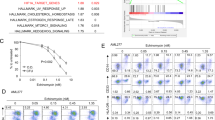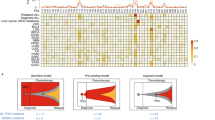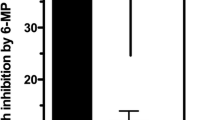Abstract
The purpose of this study is to find out the frequency of TP53 mutations in acute myeloid leukemia (AML) patients and correlate sensitivity of drug response with TP53 mutations. In AML more than 90 % of cases comprise of wild type TP53. 94.2 % of TP53 mutations are found within exon 5–8 of which 73 % are point mutations. TP53 mutations were analysed with high resolution melting curve analysis. We analysed 106 AML samples of which we found nine mutations which represents 8.5 % mutation rate and found one rare SNP. The effect of TP53 mutations were studied on the chemosensitivity of two new drugs AZD115 and RHPS4, an Aurora Kinase B inhibitor and Telomerase inhibitor respectively. Four mutations were found out of 17 for RHPS4 stating significant (p = 0.002) increase in sensitivity and no mutation found in AZD1152 database, but need more study to get definite conclusion.

Similar content being viewed by others
References
Iwakuma T, Adhikari AS. Mutant p53 gain of oncogenic function: in vivo evidence, mechanism of action and its clinical implications. Fukuoka Acta Med. 2009;100(6):217–28.
Stojnev Slavica, Golubović Mlađan, Babović Petar. TP53 gene mutations—from guardian of the genome to oncogene. Acta Medica Medianae. 2010;49(1):59–63.
Sigal A, Rotter V. Oncogenic mutations of the p53 tumor suppressor: the demons of the guardian of the genome. Cancer Res. 2000;60(24):6788–93.
Krypuy M, et al. High resolution melting for mutation scanning of TP53 exons 5–8. BMC cancer. 2007;7:168.
Grimwade D, Hills RK. Independent prognostic factors for AML outcome. Hematology. 2009;2009(1):385–95.
Ånensen N. p53 protein biosignatures in acute myeloid leukemia. Bergen: The University of Bergen; 2006.
Tao Y, et al. The aurora B kinase inhibitor AZD1152 sensitizes cancer cells to fractionated irradiation and induces mitotic catastrophe. Cell Cycle. 2009;8(19):3172–81.
Ikezoe T, et al. p53 is critical for the aurora B kinase inhibitor-mediated apoptosis in acute myelogenous leukemia cells. Int J Hematol. 2010;91(1):69–77.
Grundy M, et al. The FLT3 internal tandem duplication mutation is a secondary target of the aurora B Kinase inhibitor AZD1152-HQPA in acute myelogenous leukemia cells. Mol Cancer Ther. 2010;9(3):661–72.
Curry J, et al. Aurora B kinase inhibition in mitosis: strategies for optimizing the use of aurora kinase inhibitors such as AT9283. Cell Cycle. 2009;8(12):1921–9.
Yang J, et al. AZD1152, a novel and selective aurora B kinase inhibitor, induces growth arrest, apoptosis, and sensitization for tubulin depolymerizing agent or topoisomerase II inhibitor in human acute leukemia cells in vitro and in vivo. Blood. 2007;110(6):2034–40.
Rizzo Angela, et al. Stabilization of quadruplex DNA perturbs telomere replication leading to the activation of an ATR-dependent ATM signaling pathway. Nucl Acid Res. 2009;37:5353–64.
Salvati E, et al. Telomere damage induced by the G-quadruplex ligand RHPS4 has an antitumor effect. J Clin Investig. 2007;117(11):3236–47.
Biroccio A, et al. TRF2 inhibition triggers apoptosis and reduces tumorigenicity of human melanoma cells. Eur J Cancer. 2006;42:1881–8.
Forbes S, et al. Cosmic 2005. Br J Cancer. 2006;94(2):318–22.
Sugimoto K, et al. Frequent mutations in the P53 gene in human myeloid-leukemia cell-lines. Blood. 1992;79(9):2378–83.
Farrell PJ, et al. p53 is frequently mutated in Burkitt’s lymphoma cell lines. EMBO J. 1991;10(10):2879–87.
Gaidano G, et al. p53 mutations in human lymphoid malignancies: association with Burkitt lymphoma and chronic lymphocytic leukemia. Proc Nat Acad Sci USA. 1991;88(12):5413–7.
Nigro JM, et al. Mutations in the p53 gene occur in diverse human tumour types. Nature. 1989;342(6250):705–8.
Neubauer A, He M, Schmidt CA, et al. Genetic alterations in the p53 gene in the blast crisis of chronic myelogenous leukemia: analysis by polymerase chain reaction based techniques. Leukemia. 1993;7:593–600.
Ogino S, et al. Sensitive sequencing method for KRAS mutation detection by pyrosequencing. J Mol Diagn. 2005;7(3):413–21.
Liew M, et al. Genotyping of single-nucleotide polymorphisms by high-resolution melting of small amplicons. Clin Chem. 2004;50(7):1156–64.
Garritano S, et al. Determining the effectiveness of high resolution melting analysis for SNP genotyping and mutation scanning at the TP53 locus. BMC Genet. 2009;10(1):5.
Gonzalez-Bosquet J, et al. Detection of somatic mutations by high-resolution DNA Melting (HRM) analysis in multiple cancers. PLoS ONE. 2011;6(1):e14522.
Krypuy M, et al. High resolution melting analysis for the rapid and sensitive detection of mutations in clinical samples: KRAS codon 12 and 13 mutations in non-small cell lung cancer. BMC cancer. 2006;6(1):295.
Liew M, et al. Genotyping of single-nucleotide polymorphisms by high-resolution melting of small amplicons. Clin Chem. 2004;50(7):1156–64.
Reed GH, Wittwer CT. Sensitivity and specificity of single-nucleotide polymorphism scanning by high-resolution melting analysis. Clin Chem. 2004;50(10):1748–54.
Haferlach C, et al. Mutations of the TP53 gene in acute myeloid leukemia are strongly associated with a complex aberrant karyotype. Leukemia. 2008;22(8):1539–41.
Acknowledgments
I thank my supervisor Dr Claire Seedhouse (Haematology department, city hospital) for support and help during the entire project and Martin Grundy for providing drug database. I am obliged to all my colleagues and my family who supported me to accomplish my project successfully.
Author information
Authors and Affiliations
Corresponding author
Additional information
This article has been retracted at the request of the second author of the paper, Claire Seedhouse, whose name was included in the paper without her permission. Further, the data in the paper has been published without any approvals from the department or the institution, where the corresponding author, Ankur Shah, was working at the time of submitting this paper.
An erratum to this article is available at http://dx.doi.org/10.1007/s12291-014-0422-8.
About this article
Cite this article
Shah, A., Seedhouse, C. RETRACTED ARTICLE: Frequency of TP53 Mutations and its Impact on Drug Sensitivity in Acute Myeloid Leukemia?. Ind J Clin Biochem 27, 121–126 (2012). https://doi.org/10.1007/s12291-012-0203-1
Received:
Accepted:
Published:
Issue Date:
DOI: https://doi.org/10.1007/s12291-012-0203-1




